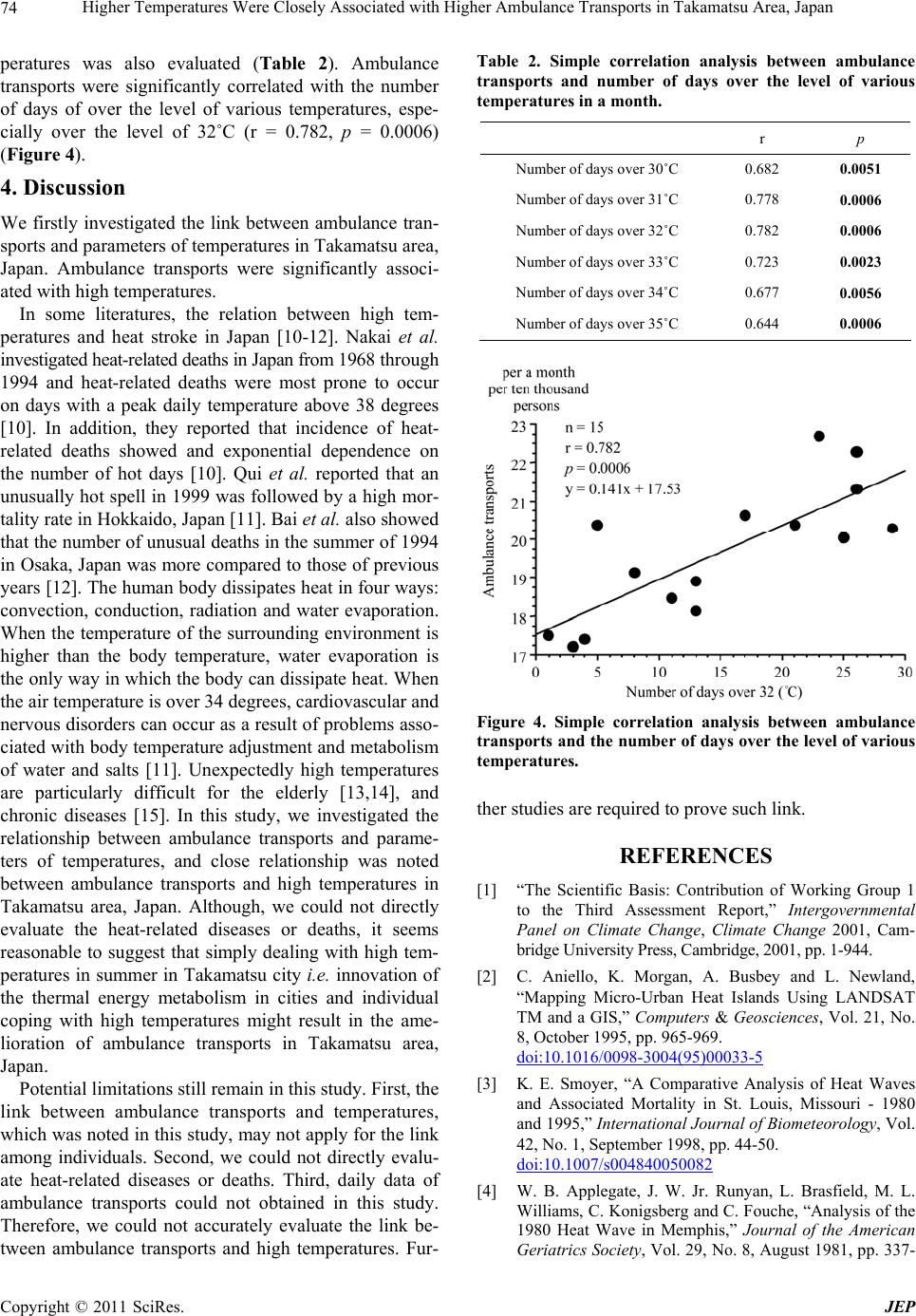
Higher Temperatures Were Closely Associated with Higher Ambulance Transports in Takamatsu Area, Japan
74
peratures was also evaluated (Table 2). Ambulance
transports were significantly correlated with the number
of days of over the level of various temperatures, espe-
cially over the level of 32˚C (r = 0.782, p = 0.0006)
(Figure 4).
4. Discussion
We firstly investigated the link between ambulance tran-
sports and parameters of temperatures in Takamatsu area,
Japan. Ambulance transports were significantly associ-
ated with high temperatures.
In some literatures, the relation between high tem-
peratures and heat stroke in Japan [10-12]. Nakai et al.
investigated heat-related deaths in Japan from 1968 through
1994 and heat-related deaths were most prone to occur
on days with a peak daily temperature above 38 degrees
[10]. In addition, they reported that incidence of heat-
related deaths showed and exponential dependence on
the number of hot days [10]. Qui et al. reported that an
unusually hot spell in 1999 was followed by a high mor-
tality rate in Hokkaido , Japan [11]. Bai et al. also showed
that the number of un usual deaths in the summer of 1994
in Osaka, Japan was more compared to those of previous
years [12]. The human body dissipates heat in four ways:
convection, conduction, radiation and water evaporation.
When the temperature of the surrounding environment is
higher than the body temperature, water evaporation is
the only way in which the body can dissipate heat. When
the air temperature is over 34 degrees, cardiovascular and
nervous disorders can occur as a result of problems asso-
ciated with body temperature adjustment and metabolism
of water and salts [11]. Unexpectedly high temperatures
are particularly difficult for the elderly [13,14], and
chronic diseases [15]. In this study, we investigated the
relationship between ambulance transports and parame-
ters of temperatures, and close relationship was noted
between ambulance transports and high temperatures in
Takamatsu area, Japan. Although, we could not directly
evaluate the heat-related diseases or deaths, it seems
reasonable to suggest that simply dealing with high tem-
peratures in summer in Takamatsu city i.e. inno vation of
the thermal energy metabolism in cities and individual
coping with high temperatures might result in the ame-
lioration of ambulance transports in Takamatsu area,
Japan.
Potential limitation s still remain in this study. First, the
link between ambulance transports and temperatures,
which was noted in th is study, may not apply for the link
among individuals. Second, we could not directly evalu-
ate heat-related diseases or deaths. Third, daily data of
ambulance transports could not obtained in this study.
Therefore, we could not accurately evaluate the link be-
tween ambulance transports and high temperatures. Fur-
Table 2. Simple correlation analysis between ambulance
transports and number of days over the level of various
temperatures in a month.
r p
Number of days over 30˚C 0.682
0.0051
Number of days over 31˚C 0.778
0.0006
Number of days over 32˚C 0.782
0.0006
Number of days over 33˚C 0.723
0.0023
Number of days over 34˚C 0.677
0.0056
Number of days over 35˚C 0.644
0.0006
Figure 4. Simple correlation analysis between ambulance
transports and the number of days over the level of various
temperatures.
ther studies are required to prove such link.
REFERENCES
[1] “The Scientific Basis: Contribution of Working Group 1
to the Third Assessment Report,” Intergovernmental
Panel on Climate Change, Climate Change 2001, Cam-
bridge University Press, Cambridge, 2001, pp. 1-944.
[2] C. Aniello, K. Morgan, A. Busbey and L. Newland,
“Mapping Micro-Urban Heat Islands Using LANDSAT
TM and a GIS,” Computers & Geosciences, Vol. 21, No.
8, October 1995, pp. 965-969.
doi:10.1016/0098-3004(95)00033-5
[3] K. E. Smoyer, “A Comparative Analysis of Heat Waves
and Associated Mortality in St. Louis, Missouri - 1980
and 1995,” International Journal of Biometeorology, Vol.
42, No. 1, September 1998, pp. 44-50.
doi:10.1007/s004840050082
[4] W. B. Applegate, J. W. Jr. Runyan, L. Brasfield, M. L.
Williams, C. Konigsberg and C. Fouche, “Analysis of the
1980 Heat Wave in Memphis,” Journal of the American
Geriatrics Society, Vol. 29, No. 8, August 1981, pp. 337-
Copyright © 2011 SciRes. JEP